转自:http://shiyanjun.cn/archives/1075.html
很好的文章
Dubbo是Alibaba开源的分布式服务框架,我们可以非常容易地通过Dubbo来构建分布式服务,并根据自己实际业务应用场景来选择合适的集群容错模式,这个对于很多应用都是迫切希望的,只需要通过简单的配置就能够实现分布式服务调用,也就是说服务提供方(Provider)发布的服务可以天然就是集群服务,比如,在实时性要求很高的应用场景下,可能希望来自消费方(Consumer)的调用响应时间最短,只需要选择Dubbo的Forking Cluster模式配置,就可以对一个调用请求并行发送到多台对等的提供方(Provider)服务所在的节点上,只选择最快一个返回响应的,然后将调用结果返回给服务消费方(Consumer),显然这种方式是以冗余服务为基础的,需要消耗更多的资源,但是能够满足高实时应用的需求。
有关Dubbo服务框架的简单使用,可以参考我的其他两篇文章(《基于Dubbo的Hessian协议实现远程调用》,《基于Dubbo的Hessian协议实现远程调用》,后面参考链接中已给出链接),这里主要围绕Dubbo分布式服务相关配置的使用来说明与实践。
Dubbo服务集群容错
假设我们使用的是单机模式的Dubbo服务,如果在服务提供方(Provider)发布服务以后,服务消费方(Consumer)发出一次调用请求,恰好这次由于网络问题调用失败,那么我们可以配置服务消费方重试策略,可能消费方第二次重试调用是成功的(重试策略只需要配置即可,重试过程是透明的);但是,如果服务提供方发布服务所在的节点发生故障,那么消费方再怎么重试调用都是失败的,所以我们需要采用集群容错模式,这样如果单个服务节点因故障无法提供服务,还可以根据配置的集群容错模式,调用其他可用的服务节点,这就提高了服务的可用性。
首先,根据Dubbo文档,我们引用文档提供的一个架构图以及各组件关系说明,如下所示:
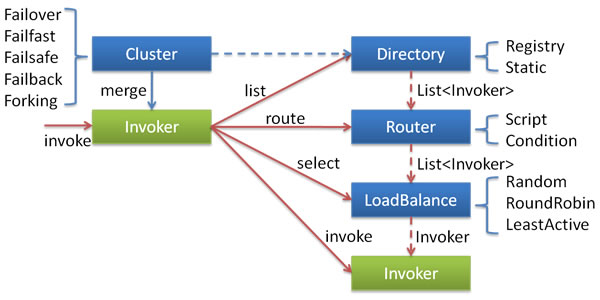
上述各个组件之间的关系(引自Dubbo文档)说明如下:
- 这里的Invoker是Provider的一个可调用Service的抽象,Invoker封装了Provider地址及Service接口信息。
- Directory代表多个Invoker,可以把它看成List,但与List不同的是,它的值可能是动态变化的,比如注册中心推送变更。
- Cluster将Directory中的多个Invoker伪装成一个Invoker,对上层透明,伪装过程包含了容错逻辑,调用失败后,重试另一个。
- Router负责从多个Invoker中按路由规则选出子集,比如读写分离,应用隔离等。
- LoadBalance负责从多个Invoker中选出具体的一个用于本次调用,选的过程包含了负载均衡算法,调用失败后,需要重选。
我们也简单说明目前Dubbo支持的集群容错模式,每种模式适应特定的应用场景,可以根据实际需要进行选择。Dubbo内置支持如下6种集群模式:
- Failover Cluster模式
配置值为failover。这种模式是Dubbo集群容错默认的模式选择,调用失败时,会自动切换,重新尝试调用其他节点上可用的服务。对于一些幂等性操作可以使用该模式,如读操作,因为每次调用的副作用是相同的,所以可以选择自动切换并重试调用,对调用者完全透明。可以看到,如果重试调用必然会带来响应端的延迟,如果出现大量的重试调用,可能说明我们的服务提供方发布的服务有问题,如网络延迟严重、硬件设备需要升级、程序算法非常耗时,等等,这就需要仔细检测排查了。
例如,可以这样显式指定Failover模式,或者不配置则默认开启Failover模式,配置示例如下:
| 1 | <dubbo:service interface="org.shirdrn.dubbo.api.ChatRoomOnlineUserCounterService" version="1.0.0" |
1 | 1 |
| 2 | cluster="failover" retries="2" timeout="100" ref="chatRoomOnlineUserCounterService" protocol="dubbo" > |
1 | 1 |
| 3 | <dubbo:method name="queryRoomUserCount" timeout="80" retries="2" /> |
1 | 1 |
| 4 | </dubbo:service> |
1 | 1 |
上述配置使用Failover Cluster模式,如果调用失败一次,可以再次重试2次调用,服务级别调用超时时间为100ms,调用方法queryRoomUserCount的超时时间为80ms,允许重试2次,最坏情况调用花费时间160ms。如果该服务接口org.shirdrn.dubbo.api.ChatRoomOnlineUserCounterService还有其他的方法可供调用,则其他方法没有显式配置则会继承使用dubbo:service配置的属性值。
- Failfast Cluster模式
配置值为failfast。这种模式称为快速失败模式,调用只执行一次,失败则立即报错。这种模式适用于非幂等性操作,每次调用的副作用是不同的,如写操作,比如交易系统我们要下订单,如果一次失败就应该让它失败,通常由服务消费方控制是否重新发起下订单操作请求(另一个新的订单)。
- Failsafe Cluster模式
配置值为failsafe。失败安全模式,如果调用失败, 则直接忽略失败的调用,而是要记录下失败的调用到日志文件,以便后续审计。
- Failback Cluster模式
配置值为failback。失败自动恢复,后台记录失败请求,定时重发。通常用于消息通知操作。
- Forking Cluster模式
配置值为forking。并行调用多个服务器,只要一个成功即返回。通常用于实时性要求较高的读操作,但需要浪费更多服务资源。
- Broadcast Cluster模式
配置值为broadcast。广播调用所有提供者,逐个调用,任意一台报错则报错(2.1.0开始支持)。通常用于通知所有提供者更新缓存或日志等本地资源信息。
上面的6种模式都可以应用于生产环境,我们可以根据实际应用场景选择合适的集群容错模式。如果我们觉得Dubbo内置提供的几种集群容错模式都不能满足应用需要,也可以定制实现自己的集群容错模式,因为Dubbo框架给我提供的扩展的接口,只需要实现接口com.alibaba.dubbo.rpc.cluster.Cluster即可,接口定义如下所示:
| 01 | @SPI(FailoverCluster.NAME) |
1 | 1 |
| 02 | public interface Cluster { |
1 | 1 |
| 03 |
1 | 1 |
| 04 | /** |
1 | 1 |
| 05 | * Merge the directory invokers to a virtual invoker. |
1 | 1 |
| 06 | * @param <T> |
1 | 1 |
| 07 | * @param directory |
1 | 1 |
| 08 | * @return cluster invoker |
1 | 1 |
| 09 | * @throws RpcException |
1 | 1 |
| 10 | */ |
1 | 1 |
| 11 | @Adaptive |
1 | 1 |
| 12 | <T> Invoker<T> join(Directory<T> directory) throws RpcException; |
1 | 1 |
| 13 |
1 | 1 |
| 14 | } |
1 | 1 |
关于如何实现一个自定义的集群容错模式,可以参考Dubbo源码中内置支持的汲取你容错模式的实现,6种模式对应的实现类如下所示:
| 1 | com.alibaba.dubbo.rpc.cluster.support.FailoverCluster |
1 | 1 |
| 2 | com.alibaba.dubbo.rpc.cluster.support.FailfastCluster |
1 | 1 |
| 3 | com.alibaba.dubbo.rpc.cluster.support.FailsafeCluster |
1 | 1 |
| 4 | com.alibaba.dubbo.rpc.cluster.support.FailbackCluster |
1 | 1 |
| 5 | com.alibaba.dubbo.rpc.cluster.support.ForkingCluster |
1 | 1 |
| 6 | com.alibaba.dubbo.rpc.cluster.support.AvailableCluster |
1 | 1 |
可能我们初次接触Dubbo时,不知道如何在实际开发过程中使用Dubbo的集群模式,后面我们会以Failover Cluster模式为例开发我们的分布式应用,再进行详细的介绍。
Dubbo服务负载均衡
Dubbo框架内置提供负载均衡的功能以及扩展接口,我们可以透明地扩展一个服务或服务集群,根据需要非常容易地增加/移除节点,提高服务的可伸缩性。Dubbo框架内置提供了4种负载均衡策略,如下所示:
- Random LoadBalance:随机策略,配置值为random。可以设置权重,有利于充分利用服务器的资源,高配的可以设置权重大一些,低配的可以稍微小一些
- RoundRobin LoadBalance:轮询策略,配置值为roundrobin。
- LeastActive LoadBalance:配置值为leastactive。根据请求调用的次数计数,处理请求更慢的节点会受到更少的请求
- ConsistentHash LoadBalance:一致性Hash策略,具体配置方法可以参考Dubbo文档。相同调用参数的请求会发送到同一个服务提供方节点上,如果某个节点发生故障无法提供服务,则会基于一致性Hash算法映射到虚拟节点上(其他服务提供方)
在实际使用中,只需要选择合适的负载均衡策略值,配置即可,下面是上述四种负载均衡策略配置的示例:
| 1 | <dubbo:service interface="org.shirdrn.dubbo.api.ChatRoomOnlineUserCounterService" version="1.0.0" |
1 | 1 |
| 2 | cluster="failover" retries="2" timeout="100" loadbalance="random" |
1 | 1 |
| 3 | ref="chatRoomOnlineUserCounterService" protocol="dubbo" > |
1 | 1 |
| 4 | <dubbo:method name="queryRoomUserCount" timeout="80" retries="2" loadbalance="leastactive" /> |
1 | 1 |
| 5 | </dubbo:service> |
1 | 1 |
上述配置,也体现了Dubbo配置的继承性特点,也就是dubbo:service元素配置了loadbalance=”random”,则该元素的子元素dubbo:method如果没有指定负载均衡策略,则默认为loadbalance=”random”,否则如果dubbo:method指定了loadbalance=”leastactive”,则使用子元素配置的负载均衡策略覆盖了父元素指定的策略(这里调用queryRoomUserCount方法使用leastactive负载均衡策略)。
当然,Dubbo框架也提供了实现自定义负载均衡策略的接口,可以实现com.alibaba.dubbo.rpc.cluster.LoadBalance接口,接口定义如下所示:
| 01 | /** |
1 | 1 |
| 02 | * LoadBalance. (SPI, Singleton, ThreadSafe) |
1 | 1 |
| 03 | * |
1 | 1 |
| 04 | * <a href="http://en.wikipedia.org/wiki/Load_balancing_(computing)">Load-Balancing</a> |
1 | 1 |
| 05 | * |
1 | 1 |
| 06 | * @see com.alibaba.dubbo.rpc.cluster.Cluster#join(Directory) |
1 | 1 |
| 07 | * @author qian.lei |
1 | 1 |
| 08 | * @author william.liangf |
1 | 1 |
| 09 | */ |
1 | 1 |
| 10 | @SPI(RandomLoadBalance.NAME) |
1 | 1 |
| 11 | public interface LoadBalance { |
1 | 1 |
| 12 |
1 | 1 |
| 13 | /** |
1 | 1 |
| 14 | * select one invoker in list. |
1 | 1 |
| 15 | * @param invokers invokers. |
1 | 1 |
| 16 | * @param url refer url |
1 | 1 |
| 17 | * @param invocation invocation. |
1 | 1 |
| 18 | * @return selected invoker. |
1 | 1 |
| 19 | */ |
1 | 1 |
| 20 | @Adaptive("loadbalance") |
1 | 1 |
| 21 | <T> Invoker<T> select(List<Invoker<T>> invokers, URL url, Invocation invocation) throws RpcException; |
1 | 1 |
| 22 |
1 | 1 |
| 23 | } |
1 | 1 |
如何实现一个自定义负载均衡策略,可以参考Dubbo框架内置的实现,如下所示的3个实现类:
| 1 | com.alibaba.dubbo.rpc.cluster.loadbalance.RandomLoadBalance |
1 | 1 |
| 2 | com.alibaba.dubbo.rpc.cluster.loadbalance.RoundRobinLoadBalance |
1 | 1 |
| 3 | com.alibaba.dubbo.rpc.cluster.loadbalance.LeastActiveLoadBalance |
1 | 1 |
Dubbo服务集群容错实践
手机应用是以聊天室为基础的,我们需要收集用户的操作行为,然后计算聊天室中在线人数,并实时在手机应用端显示人数,整个系统的架构如图所示:
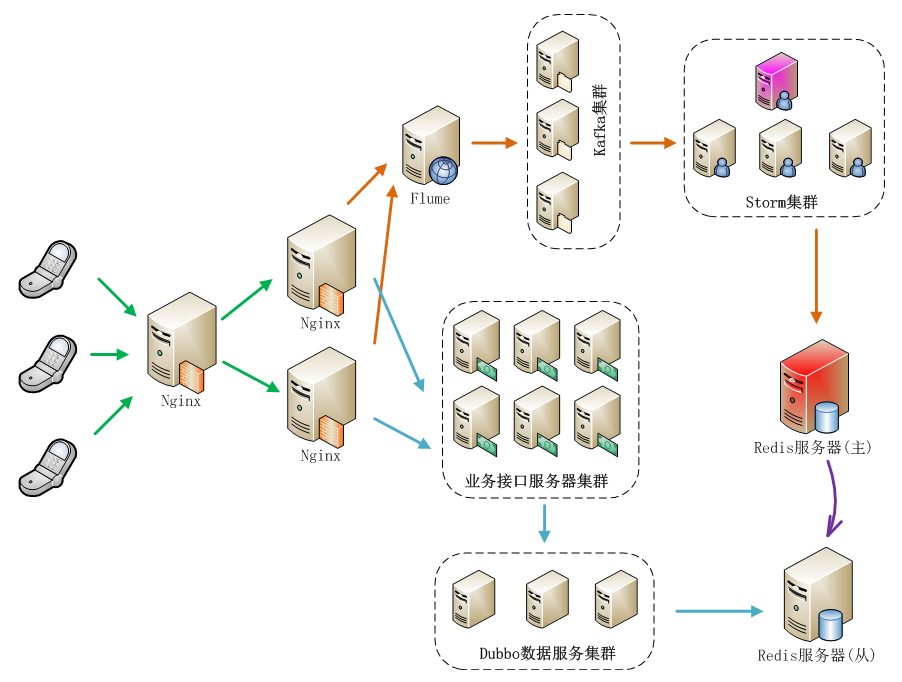
上图中,主要包括了两大主要流程:日志收集并实时处理流程、调用读取实时计算结果流程,我们使用基于Dubbo框架开发的服务来提供实时计算结果读取聊天人数的功能。上图中,实际上业务接口服务器集群也可以基于Dubbo框架构建服务,就看我们想要构建什么样的系统来满足我们的需要。
如果不使用注册中心,服务消费方也能够直接调用服务提供方发布的服务,这样需要服务提供方将服务地址暴露给服务消费方,而且也无法使用监控中心的功能,这种方式成为直连。
如果我们使用注册中心,服务提供方将服务发布到注册中心,而服务消费方可以通过注册中心订阅服务,接收服务提供方服务变更通知,这种方式可以隐藏服务提供方的细节,包括服务器地址等敏感信息,而服务消费方只能通过注册中心来获取到已注册的提供方服务,而不能直接跨过注册中心与服务提供方直接连接。这种方式的好处是还可以使用监控中心服务,能够对服务的调用情况进行监控分析,还能使用Dubbo服务管理中心,方便管理服务,我们在这里使用的是这种方式,也推荐使用这种方式。使用注册中心的Dubbo分布式服务相关组件结构,如下图所示:
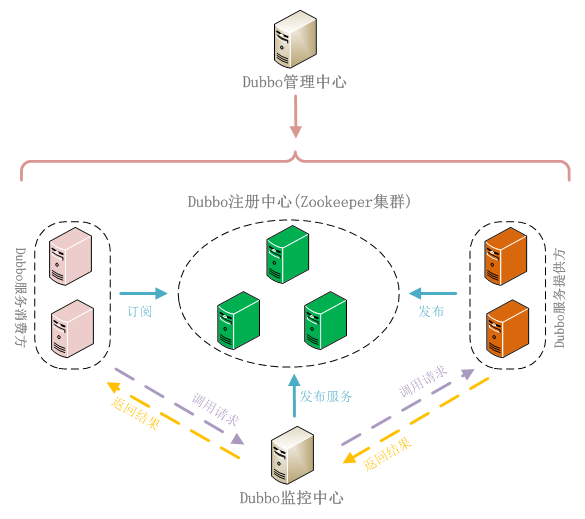
下面,开发部署我们的应用,通过如下4个步骤来完成:
- 服务接口定义
服务接口将服务提供方(Provider)和服务消费方(Consumer)连接起来,服务提供方实现接口中定义的服务,即给出服务的实现,而服务消费方负责调用服务。我们接口中给出了2个方法,一个是实时查询获取当前聊天室内人数,另一个是查询一天中某个/某些聊天室中在线人数峰值,接口定义如下所示:
| 01 | package org.shirdrn.dubbo.api; |
1 | 1 |
| 02 |
1 | 1 |
| 03 | import java.util.List; |
1 | 1 |
| 04 |
1 | 1 |
| 05 | public interface ChatRoomOnlineUserCounterService { |
1 | 1 |
| 06 |
1 | 1 |
| 07 | String queryRoomUserCount(String rooms); |
1 | 1 |
| 08 |
1 | 1 |
| 09 | List<String> getMaxOnlineUserCount(List<String> rooms, String date, String dateFormat); |
1 | 1 |
| 10 | } |
1 | 1 |
接口是服务提供方和服务消费方公共遵守的协议,一般情况下是服务提供方将接口定义好后提供给服务消费方。
- 服务提供方
服务提供方实现接口中定义的服务,其实现和普通的服务没什么区别,我们的实现类为ChatRoomOnlineUserCounterServiceImpl,代码如下所示:
| 01 | package org.shirdrn.dubbo.provider.service; |
1 | 1 |
| 02 |
1 | 1 |
| 03 | import java.util.List; |
1 | 1 |
| 04 |
1 | 1 |
| 05 | import org.apache.commons.logging.Log; |
1 | 1 |
| 06 | import org.apache.commons.logging.LogFactory; |
1 | 1 |
| 07 | import org.shirdrn.dubbo.api.ChatRoomOnlineUserCounterService; |
1 | 1 |
| 08 | import org.shirdrn.dubbo.common.utils.DateTimeUtils; |
1 | 1 |
| 09 |
1 | 1 |
| 10 | import redis.clients.jedis.Jedis; |
1 | 1 |
| 11 | import redis.clients.jedis.JedisPool; |
1 | 1 |
| 12 |
1 | 1 |
| 13 | import com.alibaba.dubbo.common.utils.StringUtils; |
1 | 1 |
| 14 | import com.google.common.base.Strings; |
1 | 1 |
| 15 | import com.google.common.collect.Lists; |
1 | 1 |
| 16 |
1 | 1 |
| 17 | public class ChatRoomOnlineUserCounterServiceImpl implements ChatRoomOnlineUserCounterService { |
1 | 1 |
| 18 |
1 | 1 |
| 19 | private static final Log LOG = LogFactory.getLog(ChatRoomOnlineUserCounterServiceImpl.class); |
1 | 1 |
| 20 | private JedisPool jedisPool; |
1 | 1 |
| 21 | private static final String KEY_USER_COUNT = "chat::room::play::user::cnt"; |
1 | 1 |
| 22 | private static final String KEY_MAX_USER_COUNT_PREFIX = "chat::room::max::user::cnt::"; |
1 | 1 |
| 23 | private static final String DF_YYYYMMDD = "yyyyMMdd"; |
1 | 1 |
| 24 |
1 | 1 |
| 25 | public String queryRoomUserCount(String rooms) { |
1 | 1 |
| 26 | LOG.info("Params[Server|Recv|REQ] rooms=" + rooms); |
1 | 1 |
| 27 | StringBuffer builder = new StringBuffer(); |
1 | 1 |
| 28 | if(!Strings.isNullOrEmpty(rooms)) { |
1 | 1 |
| 29 | Jedis jedis = null; |
1 | 1 |
| 30 | try { |
1 | 1 |
| 31 | jedis = jedisPool.getResource(); |
1 | 1 |
| 32 | String[] fields = rooms.split(","); |
1 | 1 |
| 33 | List<String> results = jedis.hmget(KEY_USER_COUNT, fields); |
1 | 1 |
| 34 | builder.append(StringUtils.join(results, ",")); |
1 | 1 |
| 35 | } catch (Exception e) { |
1 | 1 |
| 36 | LOG.error("", e); |
1 | 1 |
| 37 | } finally { |
1 | 1 |
| 38 | if(jedis != null) { |
1 | 1 |
| 39 | jedis.close(); |
1 | 1 |
| 40 | } |
1 | 1 |
| 41 | } |
1 | 1 |
| 42 | } |
1 | 1 |
| 43 | LOG.info("Result[Server|Recv|RES] " + builder.toString()); |
1 | 1 |
| 44 | return builder.toString(); |
1 | 1 |
| 45 | } |
1 | 1 |
| 46 |
1 | 1 |
| 47 | @Override |
1 | 1 |
| 48 | public List<String> getMaxOnlineUserCount(List<String> rooms, String date, String dateFormat) { |
1 | 1 |
| 49 | // HGETALL chat::room::max::user::cnt::20150326 |
1 | 1 |
| 50 | LOG.info("Params[Server|Recv|REQ] rooms=" + rooms + ",date=" + date + ",dateFormat=" + dateFormat); |
1 | 1 |
| 51 | String whichDate = DateTimeUtils.format(date, dateFormat, DF_YYYYMMDD); |
1 | 1 |
| 52 | String key = KEY_MAX_USER_COUNT_PREFIX + whichDate; |
1 | 1 |
| 53 | StringBuffer builder = new StringBuffer(); |
1 | 1 |
| 54 | if(rooms != null && !rooms.isEmpty()) { |
1 | 1 |
| 55 | Jedis jedis = null; |
1 | 1 |
| 56 | try { |
1 | 1 |
| 57 | jedis = jedisPool.getResource(); |
1 | 1 |
| 58 | return jedis.hmget(key, rooms.toArray(new String[rooms.size()])); |
1 | 1 |
| 59 | } catch (Exception e) { |
1 | 1 |
| 60 | LOG.error("", e); |
1 | 1 |
| 61 | } finally { |
1 | 1 |
| 62 | if(jedis != null) { |
1 | 1 |
| 63 | jedis.close(); |
1 | 1 |
| 64 | } |
1 | 1 |
| 65 | } |
1 | 1 |
| 66 | } |
1 | 1 |
| 67 | LOG.info("Result[Server|Recv|RES] " + builder.toString()); |
1 | 1 |
| 68 | return Lists.newArrayList(); |
1 | 1 |
| 69 | } |
1 | 1 |
| 70 |
1 | 1 |
| 71 | public void setJedisPool(JedisPool jedisPool) { |
1 | 1 |
| 72 | this.jedisPool = jedisPool; |
1 | 1 |
| 73 | } |
1 | 1 |
| 74 |
1 | 1 |
| 75 | } |
1 | 1 |
代码中通过读取Redis中数据来完成调用,逻辑比较简单。对应的Maven POM依赖配置,如下所示:
| 01 | <dependencies> |
1 | 1 |
| 02 | <dependency> |
1 | 1 |
| 03 | <groupId>org.shirdrn.dubbo</groupId> |
1 | 1 |
| 04 | <artifactId>dubbo-api</artifactId> |
1 | 1 |
| 05 | <version>0.0.1-SNAPSHOT</version> |
1 | 1 |
| 06 | </dependency> |
1 | 1 |
| 07 | <dependency> |
1 | 1 |
| 08 | <groupId>org.shirdrn.dubbo</groupId> |
1 | 1 |
| 09 | <artifactId>dubbo-commons</artifactId> |
1 | 1 |
| 10 | <version>0.0.1-SNAPSHOT</version> |
1 | 1 |
| 11 | </dependency> |
1 | 1 |
| 12 | <dependency> |
1 | 1 |
| 13 | <groupId>redis.clients</groupId> |
1 | 1 |
| 14 | <artifactId>jedis</artifactId> |
1 | 1 |
| 15 | <version>2.5.2</version> |
1 | 1 |
| 16 | </dependency> |
1 | 1 |
| 17 | <dependency> |
1 | 1 |
| 18 | <groupId>org.apache.commons</groupId> |
1 | 1 |
| 19 | <artifactId>commons-pool2</artifactId> |
1 | 1 |
| 20 | <version>2.2</version> |
1 | 1 |
| 21 | </dependency> |
1 | 1 |
| 22 | <dependency> |
1 | 1 |
| 23 | <groupId>org.jboss.netty</groupId> |
1 | 1 |
| 24 | <artifactId>netty</artifactId> |
1 | 1 |
| 25 | <version>3.2.7.Final</version> |
1 | 1 |
| 26 | </dependency> |
1 | 1 |
| 27 | </dependencies> |
1 | 1 |
有关对Dubbo框架的一些依赖,我们单独放到一个通用的Maven Module中(详见后面“附录:Dubbo使用Maven构建依赖配置”),这里不再多说。服务提供方实现,最关键的就是服务的配置,因为Dubbo基于Spring来管理配置和实例,所以通过配置可以指定服务是否是分布式服务,以及通过配置增加很多其它特性。我们的配置文件为provider-cluster.xml,内容如下所示:
| 01 | <?xml version="1.0" encoding="UTF-8"?> |
1 | 1 |
| 02 |
1 | 1 |
| 03 | <beans xmlns="http://www.springframework.org/schema/beans" |
1 | 1 |
| 04 | xmlns:xsi="http://www.w3.org/2001/XMLSchema-instance" xmlns:dubbo="http://code.alibabatech.com/schema/dubbo" |
1 | 1 |
| 05 | xmlns:p="http://www.springframework.org/schema/p" |
1 | 1 |
| 06 | xsi:schemaLocation="http://www.springframework.org/schema/beans http://www.springframework.org/schema/beans/spring-beans-3.0.xsd |
1 | 1 |
| 07 | http://code.alibabatech.com/schema/dubbo http://code.alibabatech.com/schema/dubbo/dubbo.xsd"> |
1 | 1 |
| 08 |
1 | 1 |
| 09 | <bean class="org.springframework.beans.factory.config.PropertyPlaceholderConfigurer"> |
1 | 1 |
| 10 | <property name="systemPropertiesModeName" value="SYSTEM_PROPERTIES_MODE_OVERRIDE" /> |
1 | 1 |
| 11 | <property name="ignoreResourceNotFound" value="true" /> |
1 | 1 |
| 12 | <property name="locations"> |
1 | 1 |
| 13 | <list> |
1 | 1 |
| 14 | <value>classpath*:jedis.properties</value> |
1 | 1 |
| 15 | </list> |
1 | 1 |
| 16 | </property> |
1 | 1 |
| 17 | </bean> |
1 | 1 |
| 18 |
1 | 1 |
| 19 | <dubbo:application name="chatroom-cluster-provider" /> |
1 | 1 |
| 20 | <dubbo:registry address="zookeeper://zk1:2181?backup=zk2:2181,zk3:2181" /> |
1 | 1 |
| 21 |
1 | 1 |
| 22 | <dubbo:protocol name="dubbo" port="20880" /> |
1 | 1 |
| 23 |
1 | 1 |
| 24 | <dubbo:service interface="org.shirdrn.dubbo.api.ChatRoomOnlineUserCounterService" version="1.0.0" |
1 | 1 |
| 25 | cluster="failover" retries="2" timeout="1000" loadbalance="random" actives="100" executes="200" |
1 | 1 |
| 26 | ref="chatRoomOnlineUserCounterService" protocol="dubbo" > |
1 | 1 |
| 27 | <dubbo:method name="queryRoomUserCount" timeout="500" retries="2" loadbalance="roundrobin" actives="50" /> |
1 | 1 |
| 28 | </dubbo:service> |
1 | 1 |
| 29 |
1 | 1 |
| 30 | <bean id="chatRoomOnlineUserCounterService" class="org.shirdrn.dubbo.provider.service.ChatRoomOnlineUserCounterServiceImpl" > |
1 | 1 |
| 31 | <property name="jedisPool" ref="jedisPool" /> |
1 | 1 |
| 32 | </bean> |
1 | 1 |
| 33 |
1 | 1 |
| 34 | <bean id="jedisPool" class="redis.clients.jedis.JedisPool" destroy-method="destroy"> |
1 | 1 |
| 35 | <constructor-arg index="0"> |
1 | 1 |
| 36 | <bean class="org.apache.commons.pool2.impl.GenericObjectPoolConfig"> |
1 | 1 |
| 37 | <property name="maxTotal" value="${redis.pool.maxTotal}" /> |
1 | 1 |
| 38 | <property name="maxIdle" value="${redis.pool.maxIdle}" /> |
1 | 1 |
| 39 | <property name="minIdle" value="${redis.pool.minIdle}" /> |
1 | 1 |
| 40 | <property name="maxWaitMillis" value="${redis.pool.maxWaitMillis}" /> |
1 | 1 |
| 41 | <property name="testOnBorrow" value="${redis.pool.testOnBorrow}" /> |
1 | 1 |
| 42 | <property name="testOnReturn" value="${redis.pool.testOnReturn}" /> |
1 | 1 |
| 43 | <property name="testWhileIdle" value="true" /> |
1 | 1 |
| 44 | </bean> |
1 | 1 |
| 45 | </constructor-arg> |
1 | 1 |
| 46 | <constructor-arg index="1" value="${redis.host}" /> |
1 | 1 |
| 47 | <constructor-arg index="2" value="${redis.port}" /> |
1 | 1 |
| 48 | <constructor-arg index="3" value="${redis.timeout}" /> |
1 | 1 |
| 49 | </bean> |
1 | 1 |
| 50 |
1 | 1 |
| 51 | </beans> |
1 | 1 |
上面配置中,使用dubbo协议,集群容错模式为failover,服务级别负载均衡策略为random,方法级别负载均衡策略为roundrobin(它覆盖了服务级别的配置内容),其他一些配置内容可以参考Dubbo文档。我们这里是从Redis读取数据,所以使用了Redis连接池。
启动服务示例代码如下所示:
| 01 | package org.shirdrn.dubbo.provider; |
1 | 1 |
| 02 |
1 | 1 |
| 03 | import org.shirdrn.dubbo.provider.common.DubboServer; |
1 | 1 |
| 04 |
1 | 1 |
| 05 | public class ChatRoomClusterServer { |
1 | 1 |
| 06 |
1 | 1 |
| 07 | public static void main(String[] args) throws Exception { |
1 | 1 |
| 08 | DubboServer.startServer("classpath:provider-cluster.xml"); |
1 | 1 |
| 09 | } |
1 | 1 |
| 10 |
1 | 1 |
| 11 | } |
1 | 1 |
上面调用了DubboServer类的静态方法startServer,如下所示:
| 01 | public static void startServer(String config) { |
1 | 1 |
| 02 | ClassPathXmlApplicationContext context = new ClassPathXmlApplicationContext(config); |
1 | 1 |
| 03 | try { |
1 | 1 |
| 04 | context.start(); |
1 | 1 |
| 05 | System.in.read(); |
1 | 1 |
| 06 | } catch (IOException e) { |
1 | 1 |
| 07 | e.printStackTrace(); |
1 | 1 |
| 08 | } finally { |
1 | 1 |
| 09 | context.close(); |
1 | 1 |
| 10 | } |
1 | 1 |
| 11 | } |
1 | 1 |
方法中主要是初始化Spring IoC容器,全部对象都交由容器来管理。
- 服务消费方
服务消费方就容易了,只需要知道注册中心地址,并引用服务提供方提供的接口,消费方调用服务实现如下所示:
| 01 | package org.shirdrn.dubbo.consumer; |
1 | 1 |
| 02 |
1 | 1 |
| 03 | import java.util.Arrays; |
1 | 1 |
| 04 | import java.util.List; |
1 | 1 |
| 05 |
1 | 1 |
| 06 | import org.apache.commons.logging.Log; |
1 | 1 |
| 07 | import org.apache.commons.logging.LogFactory; |
1 | 1 |
| 08 | import org.shirdrn.dubbo.api.ChatRoomOnlineUserCounterService; |
1 | 1 |
| 09 | import org.springframework.context.support.AbstractXmlApplicationContext; |
1 | 1 |
| 10 | import org.springframework.context.support.ClassPathXmlApplicationContext; |
1 | 1 |
| 11 |
1 | 1 |
| 12 | public class ChatRoomDubboConsumer { |
1 | 1 |
| 13 |
1 | 1 |
| 14 | private static final Log LOG = LogFactory.getLog(ChatRoomDubboConsumer.class); |
1 | 1 |
| 15 |
1 | 1 |
| 16 | public static void main(String[] args) throws Exception { |
1 | 1 |
| 17 | AbstractXmlApplicationContext context = new ClassPathXmlApplicationContext("classpath:consumer.xml"); |
1 | 1 |
| 18 | try { |
1 | 1 |
| 19 | context.start(); |
1 | 1 |
| 20 | ChatRoomOnlineUserCounterService chatRoomOnlineUserCounterService = (ChatRoomOnlineUserCounterService) context.getBean("chatRoomOnlineUserCounterService"); |
1 | 1 |
| 21 | getMaxOnlineUserCount(chatRoomOnlineUserCounterService); |
1 | 1 |
| 22 | getRealtimeOnlineUserCount(chatRoomOnlineUserCounterService); |
1 | 1 |
| 23 | System.in.read(); |
1 | 1 |
| 24 | } finally { |
1 | 1 |
| 25 | context.close(); |
1 | 1 |
| 26 | } |
1 | 1 |
| 27 |
1 | 1 |
| 28 | } |
1 | 1 |
| 29 |
1 | 1 |
| 30 | private static void getMaxOnlineUserCount(ChatRoomOnlineUserCounterService liveRoomOnlineUserCountService) { |
1 | 1 |
| 31 | List<String> maxUserCounts = liveRoomOnlineUserCountService.getMaxOnlineUserCount( |
1 | 1 |
| 32 | Arrays.asList(new String[] {"1482178010" , "1408492761", "1430546839", "1412517075", "1435861734"}), "20150327", "yyyyMMdd"); |
1 | 1 |
| 33 | LOG.info("After getMaxOnlineUserCount invoked: maxUserCounts= " + maxUserCounts); |
1 | 1 |
| 34 | } |
1 | 1 |
| 35 |
1 | 1 |
| 36 | private static void getRealtimeOnlineUserCount(ChatRoomOnlineUserCounterService liveRoomOnlineUserCountService) |
1 | 1 |
| 37 | throws InterruptedException { |
1 | 1 |
| 38 | String rooms = "1482178010,1408492761,1430546839,1412517075,1435861734"; |
1 | 1 |
| 39 | String onlineUserCounts = liveRoomOnlineUserCountService.queryRoomUserCount(rooms); |
1 | 1 |
| 40 | LOG.info("After queryRoomUserCount invoked: onlineUserCounts= " + onlineUserCounts); |
1 | 1 |
| 41 | } |
1 | 1 |
| 42 | } |
1 | 1 |
对应的配置文件为consumer.xml,内容如下所示:
| 01 | <?xml version="1.0" encoding="UTF-8"?> |
1 | 1 |
| 02 |
1 | 1 |
| 03 | <beans xmlns="http://www.springframework.org/schema/beans" |
1 | 1 |
| 04 | xmlns:xsi="http://www.w3.org/2001/XMLSchema-instance" xmlns:dubbo="http://code.alibabatech.com/schema/dubbo" |
1 | 1 |
| 05 | xsi:schemaLocation="http://www.springframework.org/schema/beans http://www.springframework.org/schema/beans/spring-beans-3.0.xsd |
1 | 1 |
| 06 | http://code.alibabatech.com/schema/dubbo http://code.alibabatech.com/schema/dubbo/dubbo.xsd"> |
1 | 1 |
| 07 |
1 | 1 |
| 08 | <dubbo:application name="chatroom-consumer" /> |
1 | 1 |
| 09 | <dubbo:registry address="zookeeper://zk1:2181?backup=zk2:2181,zk3:2181" /> |
1 | 1 |
| 10 |
1 | 1 |
| 11 | <dubbo:reference id="chatRoomOnlineUserCounterService" interface="org.shirdrn.dubbo.api.ChatRoomOnlineUserCounterService" version="1.0.0"> |
1 | 1 |
| 12 | <dubbo:method name="queryRoomUserCount" retries="2" /> |
1 | 1 |
| 13 | </dubbo:reference> |
1 | 1 |
| 14 |
1 | 1 |
| 15 | </beans> |
1 | 1 |
也可以根据需要配置dubbo:reference相关的属性值,也可以配置dubbo:method指定调用的方法的配置信息,详细配置属性可以参考Dubbo官方文档。
- 部署与验证
开发完成提供方服务后,在本地开发调试的时候可以怎么简单怎么做,如果是要部署到生产环境,则需要打包后进行部署,可以参考下面的Maven POM配置:
| 01 | <build> |
1 | 1 |
| 02 | <plugins> |
1 | 1 |
| 03 | <plugin> |
1 | 1 |
| 04 | <groupId>org.apache.maven.plugins</groupId> |
1 | 1 |
| 05 | <artifactId>maven-shade-plugin</artifactId> |
1 | 1 |
| 06 | <version>1.4</version> |
1 | 1 |
| 07 | <configuration> |
1 | 1 |
| 08 | <createDependencyReducedPom>true</createDependencyReducedPom> |
1 | 1 |
| 09 | </configuration> |
1 | 1 |
| 10 | <executions> |
1 | 1 |
| 11 | <execution> |
1 | 1 |
| 12 | <phase>package</phase> |
1 | 1 |
| 13 | <goals> |
1 | 1 |
| 14 | <goal>shade</goal> |
1 | 1 |
| 15 | </goals> |
1 | 1 |
| 16 | <configuration> |
1 | 1 |
| 17 | <transformers> |
1 | 1 |
| 18 | <transformer implementation="org.apache.maven.plugins.shade.resource.ServicesResourceTransformer" /> |
1 | 1 |
| 19 | <transformer implementation="org.apache.maven.plugins.shade.resource.ManifestResourceTransformer"> |
1 | 1 |
| 20 | <mainClass>org.shirdrn.dubbo.provider.ChatRoomClusterServer</mainClass> |
1 | 1 |
| 21 | </transformer> |
1 | 1 |
| 22 | </transformers> |
1 | 1 |
| 23 | </configuration> |
1 | 1 |
| 24 | </execution> |
1 | 1 |
| 25 | </executions> |
1 | 1 |
| 26 | </plugin> |
1 | 1 |
| 27 | </plugins> |
1 | 1 |
| 28 | </build> |
1 | 1 |
这里也给出Maven POM依赖的简单配置:
| 1 | <dependencies> |
1 | 1 |
| 2 | <dependency> |
1 | 1 |
| 3 | <groupId>org.shirdrn.dubbo</groupId> |
1 | 1 |
| 4 | <artifactId>dubbo-api</artifactId> |
1 | 1 |
| 5 | <version>0.0.1-SNAPSHOT</version> |
1 | 1 |
| 6 | </dependency> |
1 | 1 |
| 7 | </dependencies> |
1 | 1 |
我们开发的服务应该是分布式的,首先是通过配置内容来决定,例如设置集群模式、设置负载均衡模式等,然后在部署的时候,可以在多个节点上同一个服务,这样多个服务都会注册到Dubbo注册中心,如果某个节点上的服务不可用了,可以根据我们配置的策略来选择其他节点上的可用服务,后面通过Dubbo服务管理中心和监控中心就能更加清楚明了。
Dubbo服务管理与监控
我们需要在安装好管理中心和监控中心以后,再将上面的开发的提供方服务部署到物理节点上,然后就能够通过管理中心和监控中心来查看对应的详细情况。
- Dubbo服务管理中心
安装Dubbo服务管理中心,需要选择一个Web容器,我们使用Tomcat服务器。首先下载Dubbo管理中心安装文件dubbo-admin-2.5.3.war,或者直接从源码构建得到该WAR文件。这里,我们已经构建好对应的WAR文件,然后进行安装,执行如下命令:
| 1 | cd apache-tomcat-6.0.35 |
1 | 1 |
| 2 | rm -rf webapps/ROOT |
1 | 1 |
| 3 | unzip ~/dubbo-admin-2.5.3.war -d webapps/ROOT |
1 | 1 |
修改配置文件~/apache-tomcat-6.0.35/webapps/ROOT/WEB-INF/dubbo.properties,指定我们的注册中心地址以及登录密码,内容如下所示:
| 1 | dubbo.registry.address=zookeeper://zk1:2181?backup=zk2:2181,zk3:2181 |
1 | 1 |
| 2 | dubbo.admin.root.password=root |
1 | 1 |
| 3 | dubbo.admin.guest.password=guest |
1 | 1 |
然后,根据需要修改~/apache-tomcat-6.0.35/conf/server.xml配置文件,主要是Tomcat HTTP 端口号(我这里使用8083端口),完成后可以直接启动Tomcat服务器:
| 1 | cd ~/apache-tomcat-6.0.35/ |
1 | 1 |
| 2 | bin/catalina.sh start |
1 | 1 |
然后访问地址http://10.10.4.130:8083/即可,根据配置文件指定的root用户密码,就可以登录Dubbo管理控制台。
我们将上面开发的服务提供方服务,部署到2个独立的节点上(192.168.14.1和10.10.4.125),然后可以通过Dubbo管理中心查看对应服务的状况,如图所示:
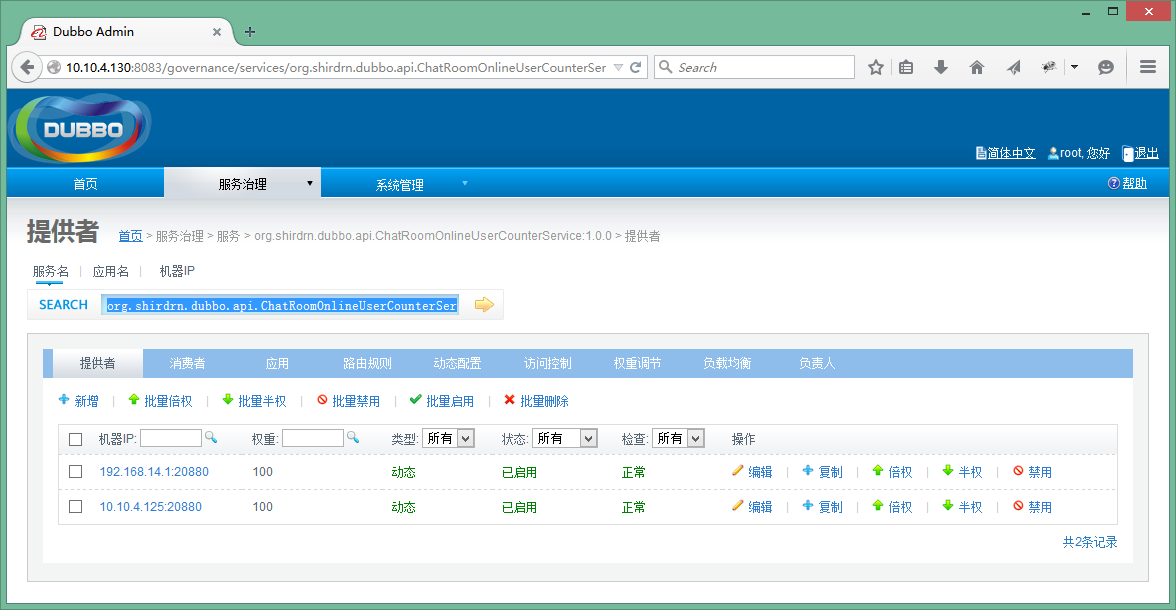
上图中可以看出,该服务有两个独立的节点可以提供,因为配置的集群模式为failover,如果某个节点的服务发生故障无法使用,则会自动透明地重试另一个节点上的服务,这样就不至于出现拒绝服务的情况。如果想要查看提供方某个节点上的服务详情,可以点击对应的IP:Port链接,示例如图所示:
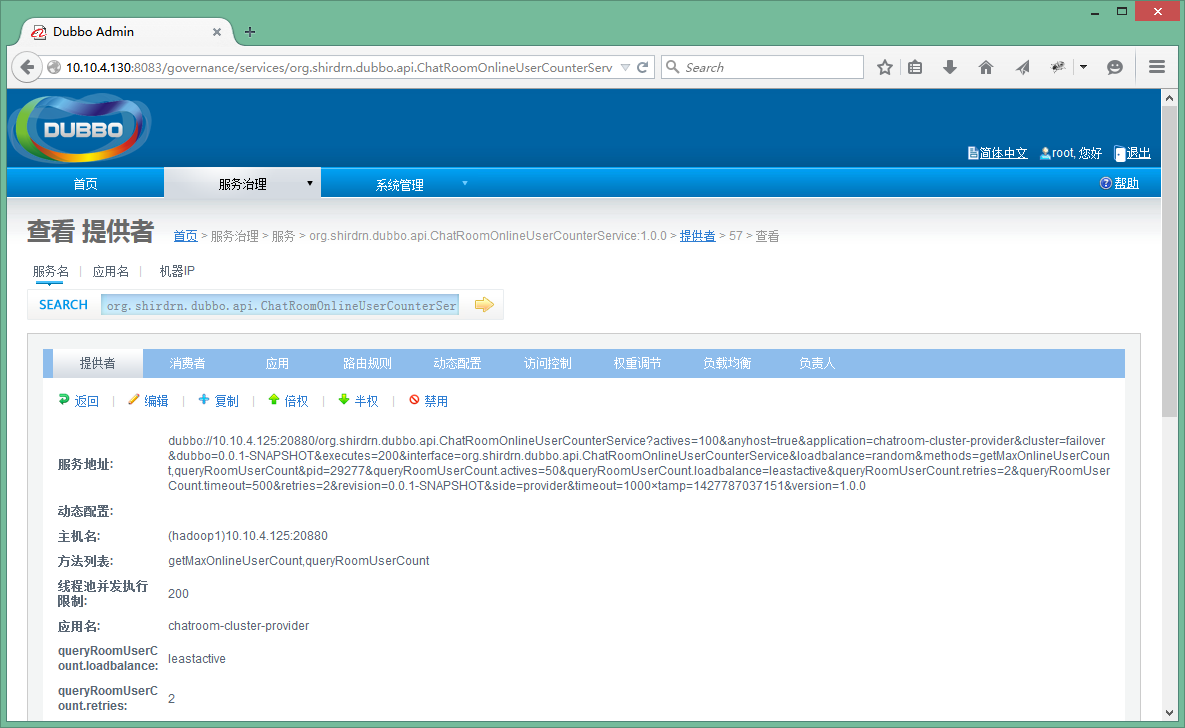
上图可以看到服务地址:
| 1 | dubbo://10.10.4.125:20880/org.shirdrn.dubbo.api.ChatRoomOnlineUserCounterService?actives=100&anyhost=true&application=chatroom-cluster-provider&cluster=failover&dubbo=0.0.1-SNAPSHOT&executes=200&interface=org.shirdrn.dubbo.api.ChatRoomOnlineUserCounterService&loadbalance=random&methods=getMaxOnlineUserCount,queryRoomUserCount&pid=30942&queryRoomUserCount.actives=50&queryRoomUserCount.loadbalance=leastactive&queryRoomUserCount.retries=2&queryRoomUserCount.timeout=500&retries=2&revision=0.0.1-SNAPSHOT&side=provider&timeout=1000×tamp=1427793652814&version=1.0.0 |
1 | 1 |
如果我们直接暴露该地址也是可以的,不过这种直连的方式对服务消费方不是透明的,如果以后IP地址更换,也会影响调用方,所以最好是通过注册中心来隐蔽服务地址。同一个服务所部署在的多个节点上,也就对应对应着多个服务地址。另外,也可以对已经发布的服务进行控制,如修改访问控制、负载均衡相关配置内容等,可以通过上图中“消费者”查看服务消费方调用服务的情况,如图所示:

也在管理控制台可以对消费方进行管理控制。
- Dubbo监控中心
Dubbo监控中心是以Dubbo服务的形式发布到注册中心,和普通的服务时一样的。例如,我这里下载了Dubbo自带的简易监控中心文件dubbo-monitor-simple-2.5.3-assembly.tar.gz,可以解压缩以后,修改配置文件~/dubbo-monitor-simple-2.5.3/conf/dubbo.properties的内容,如下所示:
| 01 | dubbo.container=log4j,spring,registry,jetty |
1 | 1 |
| 02 | dubbo.application.name=simple-monitor |
1 | 1 |
| 03 | dubbo.application.owner= |
1 | 1 |
| 04 | dubbo.registry.address=zookeeper://zk1:2181?backup=zk2:2181,zk3:2181 |
1 | 1 |
| 05 | dubbo.protocol.port=7070 |
1 | 1 |
| 06 | dubbo.jetty.port=8087 |
1 | 1 |
| 07 | dubbo.jetty.directory=${user.home}/monitor |
1 | 1 |
| 08 | dubbo.charts.directory=${dubbo.jetty.directory}/charts |
1 | 1 |
| 09 | dubbo.statistics.directory=${user.home}/monitor/statistics |
1 | 1 |
| 10 | dubbo.log4j.file=logs/dubbo-monitor-simple.log |
1 | 1 |
| 11 | dubbo.log4j.level=WARN |
1 | 1 |
然后启动简易监控中心,执行如下命令:
| 1 | cd ~/dubbo-monitor-simple-2.5.3 |
1 | 1 |
| 2 | bin/start.sh |
1 | 1 |
这里使用了Jetty Web容器,访问地址http://10.10.4.130:8087/就可以查看监控中心,Applications选项卡页面包含了服务提供方和消费方的基本信息,如图所示:

上图主要列出了所有提供方发布的服务、消费方调用、服务依赖关系等内容。
接着,查看Services选项卡页面,包含了服务提供方提供的服务列表,如图所示:

点击上图中Providers链接就能看到服务提供方的基本信息,包括服务地址等,如图所示:

点击上图中Consumers链接就能看到服务消费方的基本信息,包括服务地址等,如图所示:
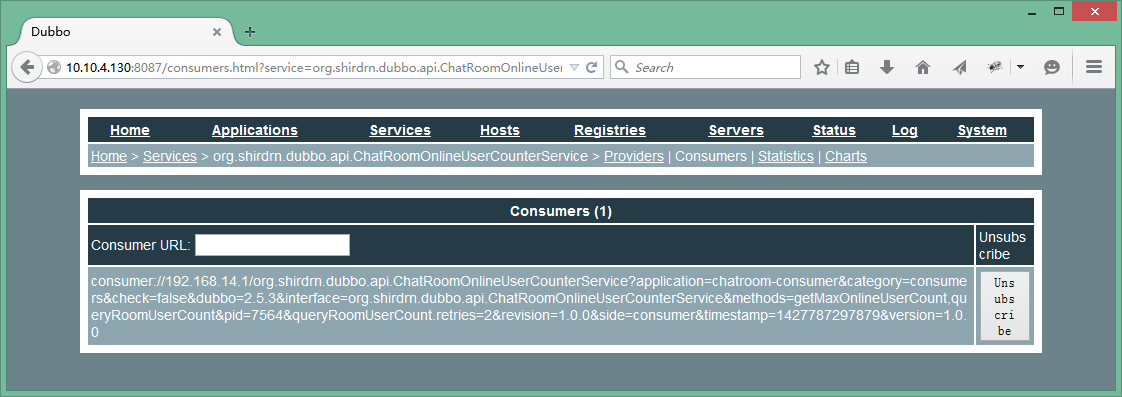
由于上面是Dubbo自带的一个简易监控中心,可能所展现的内容并不能满足我们的需要,所以可以根据需要开发自己的监控中心。Dubbo也提供了监控中心的扩展接口,如果想要实现自己的监控中心,可以实现接口com.alibaba.dubbo.monitor.MonitorFactory和com.alibaba.dubbo.monitor.Monitor,其中MonitorFactory接口定义如下所示:
| 01 | /** |
1 | 1 |
| 02 | * MonitorFactory. (SPI, Singleton, ThreadSafe) |
1 | 1 |
| 03 | * |
1 | 1 |
| 04 | * @author william.liangf |
1 | 1 |
| 05 | */ |
1 | 1 |
| 06 | @SPI("dubbo") |
1 | 1 |
| 07 | public interface MonitorFactory { |
1 | 1 |
| 08 |
1 | 1 |
| 09 | /** |
1 | 1 |
| 10 | * Create monitor. |
1 | 1 |
| 11 | * @param url |
1 | 1 |
| 12 | * @return monitor |
1 | 1 |
| 13 | */ |
1 | 1 |
| 14 | @Adaptive("protocol") |
1 | 1 |
| 15 | Monitor getMonitor(URL url); |
1 | 1 |
| 16 |
1 | 1 |
| 17 | } |
1 | 1 |
Monitor接口定义如下所示:
| 1 | /** |
1 | 1 |
| 2 | * Monitor. (SPI, Prototype, ThreadSafe) |
1 | 1 |
| 3 | * |
1 | 1 |
| 4 | * @see com.alibaba.dubbo.monitor.MonitorFactory#getMonitor(com.alibaba.dubbo.common.URL) |
1 | 1 |
| 5 | * @author william.liangf |
1 | 1 |
| 6 | */ |
1 | 1 |
| 7 | public interface Monitor extends Node, MonitorService { |
1 | 1 |
| 8 |
1 | 1 |
| 9 | } |
1 | 1 |
具体定义内容可以查看MonitorService接口,不再累述。
总结
Dubbo还提供了其他很多高级特性,如路由规则、参数回调、服务分组、服务降级等等,而且很多特性在给出内置实现的基础上,还给出了扩展的接口,我们可以给出自定义的实现,非常方便而且强大。更多可以参考Dubbo官网用户手册和开发人员手册。
附录:Dubbo使用Maven构建依赖配置
| 01 | <properties> |
1 | 1 |
| 02 | <spring.version>3.2.8.RELEASE</spring.version> |
1 | 1 |
| 03 | <project.build.sourceEncoding>UTF-8</project.build.sourceEncoding> |
1 | 1 |
| 04 | </properties> |
1 | 1 |
| 05 |
1 | 1 |
| 06 | <dependencies> |
1 | 1 |
| 07 | <dependency> |
1 | 1 |
| 08 | <groupId>com.alibaba</groupId> |
1 | 1 |
| 09 | <artifactId>dubbo</artifactId> |
1 | 1 |
| 10 | <version>2.5.3</version> |
1 | 1 |
| 11 | <exclusions> |
1 | 1 |
| 12 | <exclusion> |
1 | 1 |
| 13 | <groupId>org.springframework</groupId> |
1 | 1 |
| 14 | <artifactId>spring</artifactId> |
1 | 1 |
| 15 | </exclusion> |
1 | 1 |
| 16 | <exclusion> |
1 | 1 |
| 17 | <groupId>org.apache.zookeeper</groupId> |
1 | 1 |
| 18 | <artifactId>zookeeper</artifactId> |
1 | 1 |
| 19 | </exclusion> |
1 | 1 |
| 20 | <exclusion> |
1 | 1 |
| 21 | <groupId>org.jboss.netty</groupId> |
1 | 1 |
| 22 | <artifactId>netty</artifactId> |
1 | 1 |
| 23 | </exclusion> |
1 | 1 |
| 24 | </exclusions> |
1 | 1 |
| 25 | </dependency> |
1 | 1 |
| 26 | <dependency> |
1 | 1 |
| 27 | <groupId>org.springframework</groupId> |
1 | 1 |
| 28 | <artifactId>spring-core</artifactId> |
1 | 1 |
| 29 | <version>${spring.version}</version> |
1 | 1 |
| 30 | </dependency> |
1 | 1 |
| 31 | <dependency> |
1 | 1 |
| 32 | <groupId>org.springframework</groupId> |
1 | 1 |
| 33 | <artifactId>spring-beans</artifactId> |
1 | 1 |
| 34 | <version>${spring.version}</version> |
1 | 1 |
| 35 | </dependency> |
1 | 1 |
| 36 | <dependency> |
1 | 1 |
| 37 | <groupId>org.springframework</groupId> |
1 | 1 |
| 38 | <artifactId>spring-context</artifactId> |
1 | 1 |
| 39 | <version>${spring.version}</version> |
1 | 1 |
| 40 | </dependency> |
1 | 1 |
| 41 | <dependency> |
1 | 1 |
| 42 | <groupId>org.springframework</groupId> |
1 | 1 |
| 43 | <artifactId>spring-context-support</artifactId> |
1 | 1 |
| 44 | <version>${spring.version}</version> |
1 | 1 |
| 45 | </dependency> |
1 | 1 |
| 46 | <dependency> |
1 | 1 |
| 47 | <groupId>org.springframework</groupId> |
1 | 1 |
| 48 | <artifactId>spring-web</artifactId> |
1 | 1 |
| 49 | <version>${spring.version}</version> |
1 | 1 |
| 50 | </dependency> |
1 | 1 |
| 51 |
1 | 1 |
| 52 | <dependency> |
1 | 1 |
| 53 | <groupId>org.slf4j</groupId> |
1 | 1 |
| 54 | <artifactId>slf4j-api</artifactId> |
1 | 1 |
| 55 | <version>1.6.2</version> |
1 | 1 |
| 56 | </dependency> |
1 | 1 |
| 57 | <dependency> |
1 | 1 |
| 58 | <groupId>log4j</groupId> |
1 | 1 |
| 59 | <artifactId>log4j</artifactId> |
1 | 1 |
| 60 | <version>1.2.16</version> |
1 | 1 |
| 61 | </dependency> |
1 | 1 |
| 62 | <dependency> |
1 | 1 |
| 63 | <groupId>org.javassist</groupId> |
1 | 1 |
| 64 | <artifactId>javassist</artifactId> |
1 | 1 |
| 65 | <version>3.15.0-GA</version> |
1 | 1 |
| 66 | </dependency> |
1 | 1 |
| 67 | <dependency> |
1 | 1 |
| 68 | <groupId>com.alibaba</groupId> |
1 | 1 |
| 69 | <artifactId>hessian-lite</artifactId> |
1 | 1 |
| 70 | <version>3.2.1-fixed-2</version> |
1 | 1 |
| 71 | </dependency> |
1 | 1 |
| 72 | <dependency> |
1 | 1 |
| 73 | <groupId>com.alibaba</groupId> |
1 | 1 |
| 74 | <artifactId>fastjson</artifactId> |
1 | 1 |
| 75 | <version>1.1.8</version> |
1 | 1 |
| 76 | </dependency> |
1 | 1 |
| 77 | <dependency> |
1 | 1 |
| 78 | <groupId>org.jvnet.sorcerer</groupId> |
1 | 1 |
| 79 | <artifactId>sorcerer-javac</artifactId> |
1 | 1 |
| 80 | <version>0.8</version> |
1 | 1 |
| 81 | </dependency> |
1 | 1 |
| 82 | <dependency> |
1 | 1 |
| 83 | <groupId>org.apache.zookeeper</groupId> |
1 | 1 |
| 84 | <artifactId>zookeeper</artifactId> |
1 | 1 |
| 85 | <version>3.4.5</version> |
1 | 1 |
| 86 | </dependency> |
1 | 1 |
| 87 | <dependency> |
1 | 1 |
| 88 | <groupId>com.github.sgroschupf</groupId> |
1 | 1 |
| 89 | <artifactId>zkclient</artifactId> |
1 | 1 |
| 90 | <version>0.1</version> |
1 | 1 |
| 91 | </dependency> |
1 | 1 |
| 92 | <dependency> |
1 | 1 |
| 93 | <groupId>org.jboss.netty</groupId> |
1 | 1 |
| 94 | <artifactId>netty</artifactId> |
1 | 1 |
| 95 | <version>3.2.7.Final</version> |
1 | 1 |
| 96 | </dependency> |
1 | 1 |
| 97 | </dependencies> |
1 | 1 |
参考链接
- http://alibaba.github.io/dubbo-doc-static/User+Guide-zh.htm
- http://alibaba.github.io/dubbo-doc-static/User+Guide-zh.htm\#UserGuide-zh-%E9%9B%86%E7%BE%A4%E5%AE%B9%E9%94%99
- http://alibaba.github.io/dubbo-doc-static/cluster.jpg-version=1&modificationDate=1321028038000.jpg
- http://alibaba.github.io/dubbo-doc-static/User+Guide-zh.htm\#UserGuide-zh-%E7%AD%96%E7%95%A5%E6%88%90%E7%86%9F%E5%BA%A6
- http://alibaba.github.io/dubbo-doc-static/User+Guide-zh.htm\#UserGuide-zh-%E8%B4%9F%E8%BD%BD%E5%9D%87%E8%A1%A1
- http://alibaba.github.io/dubbo-doc-static/Developer+Guide-zh.htm\#DeveloperGuide-zh-%E8%B4%9F%E8%BD%BD%E5%9D%87%E8%A1%A1%E6%89%A9%E5%B1%95
- http://coolshell.cn/articles/4787.html
- http://shiyanjun.cn/archives/349.html
- http://shiyanjun.cn/archives/341.html
